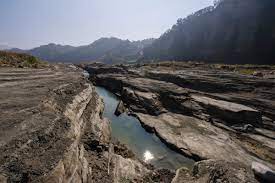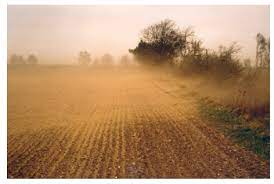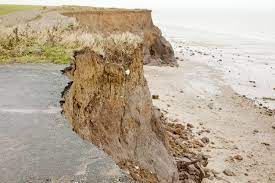Impact of soil erosion on soil fertility and its remedies
Rock erosion is the process of disintegration and decomposition of rocks and minerals. Disintegration is a physical process, whereas decomposition is a chemical process.

Land Construction :
Soil is formed as a result of rock erosion or erosion process. Rock erosion is the process of disintegration and decomposition of rocks and minerals. Disintegration is a physical process, whereas decomposition is a chemical process. Rock erosion is caused by a number of biological and inorganic factors. Physical wear and tear are caused by heat, cold, freezing water, flowing water, ocean waves, glaciers, and wind. Chemical depletion is caused by various actions such as solution hydrolysis, hydrolysis, carburization, anabolism, catabolism. Factors like (1) Climate (2) Organisms (flora and fauna), (3) Maternal-rock (4) Surface factors, and (5) Time, etc. are responsible for the process of land formation and development.
Among these factors, climate and organisms are known as 'active factors' because of their direct effect or action on soil formation. While maternal rock, surface factors, and time do not directly affect or play an active part in the soil formation process, they are known as passive factors. Soil formation occurs due to the geographical process of active factors and this process is called erosion or weathering.
Impact of land on the local environment :
The shape, height, slope, position, and openness of the land surface affect the local environmental factors and therefore the environment of the area.
The shape of the soil accumulates by blocking the rain winds and hence more rainfall falls in the area. Humidity is higher in mountainous areas and the temperature difference is less. Thus, there is a great difference between the climate of a mountainous area with a uniform average temperature and the climate of a plain area.
The height of the place affects the sun - radiation, temperature, and rainfall so it has a very big effect on the vegetation.
Land slope affects excess water runoff and soil drainage. As such, it affects the soil moisture area. As a general rule, the higher the slope, the faster the flow and the higher the displacement. As such, the permeability of the mountain slopes and the middle slopes of the foothills is good; While the land of the plains is very flat, its disposability is very low.
Slopes affect soil erosion and soil depth. In general, the higher the slope, the higher the erosion because the higher the slope, the higher the erosion rate. Even if there is no erosion of the soil in the hilly region, the soil often slips under its own weight and accumulates in the low sloping plains of the foothills. So as we go up the slope of the mountain, the depth of the ground decreases; While the foothills and valleys are deeper. The soil on the slopes of the mountains is constantly accumulated in the rain-soaked valleys and plains, so it has a high proportion of compost. In mountainous areas of Gujarat, soil erosion washes away the topsoil and accumulates at the bottom. It, therefore, has an adverse effect on forest areas at the top of mountainous areas. So day by day the tops of the mountainous areas are becoming body.
The relationship between land and water :
The main source of water on earth is rain and snow. Some of the rainwater that falls on the ground is dissolved in the soil through soil particles and pores. This water accumulates in the cracks of deep rocks or rocks above the rocks. The inflow of rainwater into the soil depends on factors such as rainfall intensity, soil nature, the proportion of topsoil, and vegetation in the soil. If the intensity of rainfall is very high then most of the rainwater is wasted by flowing over the soil and at the same time it also erodes the soil on a large scale. If there is a layer of compost on the surface of the soil and the soil is porous and dry then most of the rainwater is absorbed by the soil. The vegetation on the ground prevents rainwater from falling directly on the soil at high speeds and therefore the pores of the soil do not close and as a result, rainwater seeps into the soil and all the water flows away.
Factors of soil fertility :
(1) Soil organic matter :
(a) Vegetative waste :
Trees and other vegetation return most of the nutrients obtained from the soil to the soil in the form of leaves, twigs, bark, fruits, flowers, etc. All this waste is known as 'vegetable waste'. Vegetable waste is in the uppermost layers of soil, consisting of fresh litter and some decomposed waste, and often contains bark fragments, twigs, etc., along with leaves.
Along with the vegetative waste on the ground, there are also dead remains of animals, roots, other dried plants and aids in their decomposition. All this waste together is known as ' organic matter '. Organic matter includes the remains of plants and animals at various stages of decomposition, cells, and tissues of micro-organisms present in the soil, micro-organisms, and the substances synthesized by them. Organic matter is usually called organic matter which is sifted through the soil by sifting through a 3 mm sieve.
(b) Compost :
Soil consists of decomposed leaves, twigs, bark, etc., and all decomposed or not organic matter, but the dark asphalt (shapeless) part of most organic matter is referred to as 'compost'. The constitutional unit of compost has no special structure and it is very difficult to identify this unit. Thus, compost is the most completely decomposed part of the organic matter of the soil which forms a distinct layer and merges perfectly with the soil.
Soil improves the physical properties of the soil as it merges with the soil and forms a layer on the soil. Soil improves topography by mixing with clay. Increases water storage capacity and groundwater inflow rate. Soil improves the adhesion of sandy soil thus improving the texture of the soil. This increases the moisture capacity of the soil. Soil increases soil circulation and water drainage in clayey soils. The compost mixes with the soil, otherwise, it is spread over the surface of the soil as a layer and provides a shield against the harmful effects of sun rays, rain and wind, and water erosion of the soil.
Soil is a major source of nutrients for plants. When the soil mixes with the soil, the minerals in the organic matter return to the soil. Plant ammonia and nitrite contain nitrogenous organic compounds. It is converted to ammonia and nitrite and at the end of this process, it is converted to plant nitrate. Soil is in the form of calcareous and hence the addition of it to the soil increases the ‘corrosion exchange capacity’ of the soil.
(2) Minerals in the soil :
Many minerals have been identified from the Earth's crust so far but very few minerals play a role in most soil formation. Many of the remaining minerals are then important as a source of plant nutrients. Minerals are present in rocks in the form of crystals. Minerals have specific chemical properties. There are mainly two types of minerals found in the soil. One main - primary and the other secondary minerals. Among the important primary minerals in the soil are felspar, mica, hornblende, olivine, phosphorite, aperite, magnetite, quartz, calcite dolomite, etc. Secondary minerals include clay minerals and aqueous hydroxide minerals. Caliente, montmorillonite, and elite are important clay minerals of the secondary section.
Soil erosion :
The process of natural soil formation is much slower and the erosion process is much faster than that. According to an estimate, it takes 300 to 400 years for a 1 cm layer of soil to form under the influence of natural factors under normal conditions. One hectare of such land weighs about 180 metric tons. On the other hand, on a land with a slope of only 1.25 percent, if 20 cm. At least 6 metric tons of soil are washed away every year when it rains (12.5 inches). In this way, a layer of 1 cm prepared in 400 years can be washed in only 12 years! Erosion in this way adversely affects agriculture and drastically reduces crop yields.
Soil erosion is the process by which soil particles are released and carried from one place to another by air or water. Most of the land surveys have shown that the quality of the soil is declining due to various human activities.
Types of Erosion :
Land erosion is mainly caused by rainwater, wind, and sea waves. Factors like improper use of land, destruction of vegetation, faulty planting method, uncontrolled grazing of animals, wrong method of irrigation, industrialization, overconsumption, etc. are also responsible for soil erosion.
(1) Rainwater erosion :

When it is raining heavily in the monsoon, we always see water flowing in rivers, ditches, ditches, etc. This water is turbid because it contains very valuable soil fertile particles and nutrients. Do we think that such particles are going to wash away the soil? But if it is calculated correctly, millions of tons of valuable clay are washed away in this way. There are three types of erosion.
(a) Sheet Erosion :

This type of erosion usually occurs in slow sloping and unpaved lands on one side. In it, the top layer of soil is washed evenly. This type of erosion is not noticeable at the beginning so it causes a lot of damage. In addition, soil topsoil is rich in nutrients along with soil particles. Such sheet erosion is caused by TB of the soil. This is because it slowly erodes the texture of the soil in a way that is not noticeable, reducing productivity and making it useless.
(b) Incisional Erosion :

When the slope of the land is high, the rainfall is high and when the land is exposed, the water accumulated on the surface of the land flows rapidly and there is a nick-like shape. If more water is found there and it continues to flow, then such a ditch goes deeper. Such small incisions cut into the ground; As a result, both the upper and lower layers of soil are washed away. The land then becomes pitted, not cultivable. If left unmanaged, they can be left astray and lose the right path.
(c) Gorge Erosion :

This type of erosion occurs in soils with different directions and slopes. Where two slopes meet, water flows together. This water washes away the topsoil as well as the topsoil. This erosion appears immediately. The erosion of the Mahi and Sabarmati rivers in Gujarat is such an erosion.
(d) Wind Erosion :

Winds that come in the form of strong winds and whirlwinds raise the soil in the upper layer of the soil and drag it with them to other places. Such erosion causes severe damage to the vegetation of the region. Soil or sand eroded by wind damages vegetation, roads, canals, etc. Desert and coastal sands are scattered over the fertile land near it by wind and turn it into barren land.
(3) Seawater Erosion:

Huge waves crashing against the fertile land along the coast erodes the land. The same thing happens on the shores of huge lakes. This type of erosion is special if the soil on such banks is open and sandy without vegetation. Such various erosions are based on the type of soil, soil slope, subsoil, tillage, rainfall, speed of rainfall, climate, vegetation cover, crop quality, outside water intake, etc.
Land erosion has reduced its fertility, affecting the economic condition of the area in four ways.
(1) Continuous erosion of fertile topsoil leads to continuous increase in infertile soil area.
(2) The river-ditch is closed (check-up) for flowing with the flow of water so flooding occurs.
(3) Excessive soil erosion reduces the irrigation capacity of dams built for irrigation by exceeding the soil filling deposition estimate.
(4) Excessive erosion causes rainwater to flow into the oceans instead of being drained into the ground, thus lowering the groundwater table and creating drought-like conditions.
Thus, the above four types of erosion have a huge impact on the economic condition of the area.
Apart from this, soil erosion has resulted in depletion of soil moisture capacity, reduction of topsoil, depletion of soil nutrients, depletion of soil productivity, depletion of soil by deposition in irrigation canals, arable lands, water storage areas, ponds, etc. This has an impact on water quality and also on businesses like fisheries and also on long-term 'sustainable crop production' in such an unbalanced situation. ‘Sustainable crop production' is the standard of quantity and quality of good crops taken in one place, a condition.
Topland erosion also affects crop yields, which is equivalent to a total land loss of about one percent per year. Many farmers either use more chemical fertilizers or cultivate new land to make up for the shortfall. An estimated 250 billion tons of farmland is eroded worldwide each year! And it also erodes almost twice as much grassland, forests, and human habitation. ! Soil erosion also reduces soil nutrients, water storage, and digestibility. This has an effect on the amount of groundwater; And its dependence on the quantity and quality of irrigation water. Thus soil erosion and fertility have a direct and indirect effect on the quality of human life and the environment as a whole.
Excessive rainfall recharges or replenishes drinking and irrigated water sources in the area so that next season's crops can be grown well with irrigated water but soil erosion in the unit area also erodes nutrients which adversely affects crop production and Often, rainwater harvesting in the same area for long periods of time causes soil-borne diseases and due to which plants cannot properly remove nutrients from the soil.
Soil erosion When the top layer of soil is eroded, the organic matter and essential nutrients in the upper layer also flow away. This type of erosion is mainly due to the erosion of nitrogen, sulfur, and chloride. Other nutrients are also deficient but in small amounts. Nitrogen deficiency can be detected by signs of deficiency or by face-to-face visits. Nitrogen deficiency causes the lower leaves of the plant to turn yellow first and then often the legume crops as well.
Lack of sulfur makes the whole plant turn yellow but the intensity is more in the upper leaves. Plant yellowing is seen in many ways like plant disease, deficiency of other elements due to excess moisture in the soil, etc. In such circumstances, it becomes difficult to cultivate the soil and plants. Accurate information is obtained by taking a soil sample and analyzing it in a laboratory to find out the number of nutrients in the soil and more production can be obtained by supplying the right amount of missing nutrients.
To solve this problem of soil erosion, leveling the soil, planting horizontally from the slope, plowing horizontally from the slope, plowing the land before rain, deep plowing, increasing the use of organic manure, increasing water drainage in the soil, constructing ridges along the contour line, to do. Soil erosion can be reduced by measures such as tillage, proper use of land, protection of weeds, maintenance of trees, etc.





